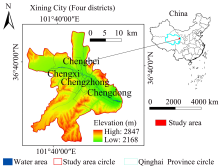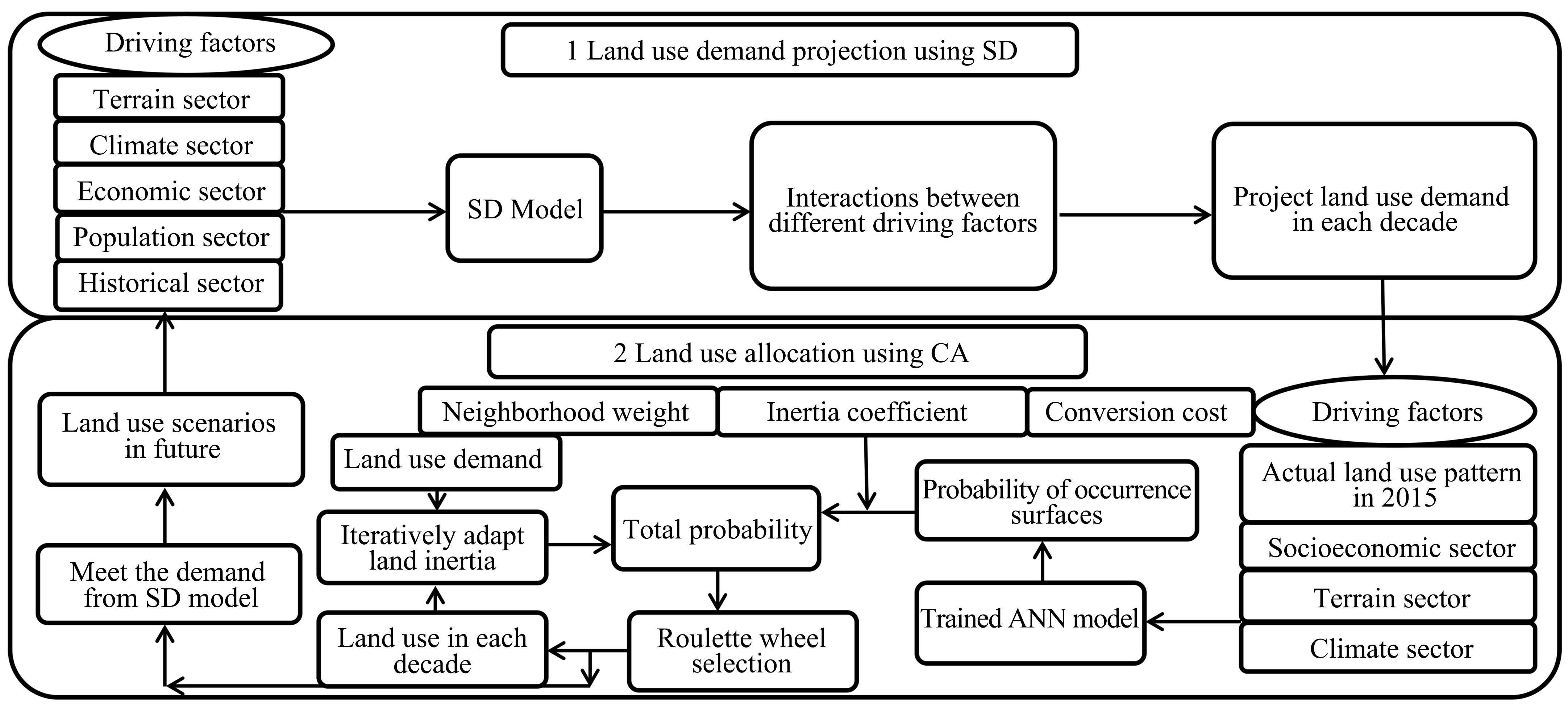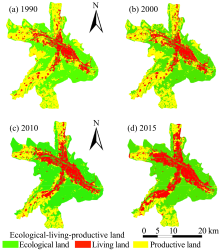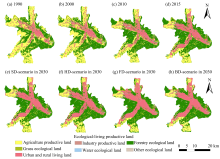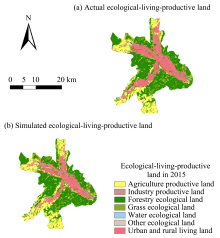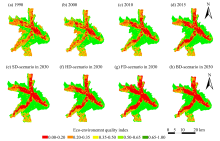Sciences in Cold and Arid Regions ›› 2019, Vol. 11 ›› Issue (3): 194–207.doi: 10.3724/SP.J.1226.2019.00194.
Assessing the impacts of ecological-living-productive land changes on eco-environmental quality in Xining City on Qinghai-Tibet Plateau, China
ZiYi Gao1,HaiFeng Zhang1( ),XiaoNan Yang2,ZhiYuan Song3
),XiaoNan Yang2,ZhiYuan Song3
- 1. School of Geographical Science, Qinghai Normal University, Xining, Qinghai 810008, China
2. Institute of Soil and Water Conservation, Northwest Agriculture and Forestry University, Yangling, Shaanxi 712100, China
3. Department of Computer Science and Technology, Lvliang University, Lvliang, Shanxi 033000, China
|
Bakker MM , Govers G , Kosmas C , et al ., 2005. Soil erosion as a driver of land use change. Agriculture Ecosystems and Environment, 105(3): 467-481. DOI: 10.1016/j.agee. 2004.07.009 .
doi: 10.1016/j.agee. 2004.07.009 |
|
|
Barrett CB , Travis AJ , Dasgupta P , 2011. On biodiversity conservation and poverty traps. Proceedings of the National Academy of Sciences, 108: 13907-13912. DOI: 10.1073/pnas.1011521108 .
doi: 10.1073/pnas.1011521108 |
|
|
Cai EX , Jing Y , Liu YL , et al ., 2018. Spatial-temporal patterns and driving forces of ecological-living-production land in Hubei Province, Central China. Sustainability, 10(1): 66-80. DOI: 10.3390/su10010066 .
doi: 10.3390/su10010066 |
|
| Chu D , Zhang YL , Zheng D , 2005. Land use change scenario in Lhasa district using Markov chain model. Geographical Research, 24(6): 869-877. (in Chinese) | |
| Chu D , Zhang YL , Zheng D , 2006. Land use change in Lhasa area, Tibet from 1990 to 2000. Acta Geographica Sinica, 61(10): 1075-1083. (in Chinese) | |
|
Cui J , Zang SY , 2013. Regional disparities of land use changes and their eco-environmental effects in Harbin-Daqing-Qiqihar Industrial Corridor. Geographical Research, 32(5): 848-856. DOI: 10.11821/yj2013050008 .
doi: 10.11821/yj2013050008 |
|
| Dang LJ , Xu Y , Gao Y , 2014. Assessment method of functional land use classification and spatial system: A case study of Yangou Watershed. Research of Soil and Water Conservation, 21(5): 193-197. (in Chinese) | |
|
Fan J, 2015. Draft of major function oriented zoning of China. Acta Geographica Sinica, 70(2): 186-201. DOI: 10.11821/dlxb201502002 .
doi: 10.11821/dlxb201502002 |
|
|
Fu Y , Xiao JS , Xiao RX , et al ., 2009. Analysis and simulation prediction on LUCC of Xining city based on RS and GIS. Transactions of the CSAE, 25(7): 211-218. DOI: 10.3969/j.issn.1002-6819.2009.07.039 .
doi: 10.3969/j.issn.1002-6819.2009.07.039 |
|
| Gu SZ , Hu YG , Zhou H , 2013. Ecological civilization construction: Scientific connotation and basic paths. Resources Science, 35(1): 2-13. (in Chinese) | |
|
Han Z , Song W , Deng XZ , 2016. Responses of ecosystem service to land use change in Qinghai Province. Energies, 9(4): 303-318. DOI: 10.3390/en9040303 .
doi: 10.3390/en9040303 |
|
|
Hoyos LE, Cabido MR , Cingolani AM , 2018. A multivariate approach to study drivers of land-cover changes through remote sensing in the dry chaco of Argentina. International Journal of Geo-Information, 7(5): 170-184. DOI: 10.3390/ijgi7050170 .
doi: 10.3390/ijgi7050170 |
|
|
Jia ZM , Ma BR , Zhang J , et al ., 2018. Simulating spatial-temporal changes of land-use based on ecological redline restrictions and landscape driving factors: A case study in Beijing. Sustainability, 10(4): 1299-1316. DOI: 10.3390/su10041299 .
doi: 10.3390/su10041299 |
|
|
Jiang B , Bai Y , Wong CP , et al ., 2019. China's ecological civilization program-Implementing ecological redline policy. Land Use, 81: 111-114. DOI: 10.1016/j.landusepol.2018. 10.031 .
doi: 10.1016/j.landusepol.2018. 10.031 |
|
| Li WS , Li JF , Yao Y , et al ., 2016. Consolidation division of rural residential areas based on reconstruction of production, living and ecology space: A case study of Guandang Town of Shayang County in Jingzhou City of Hubei Province. Areal Research and Development, 35(1): 139-143. (in Chinese) | |
| Li XW , Fang CL , Huang JC , 2003. The urban land use tranformations and associated effects on eco-enviroment in northwest China arid region: a case study in Hexi region, Gansu Province. Quaternary Sciences, 23(3): 280-290. (in Chinese) | |
| Li YC , Liu CM , Yu JJ , 2006. Trade-off of conflict between wetland protection and farmland reclamation in the Sanjiang Plain, Heilongjiang Province. Journal of Beijing Forestry University, 28(1): 39-42. (in Chinese) | |
|
Liang X , Liu XP , Li X , et al ., 2018. Delineating multi-scenario urban growth boundaries with a CA-based FLUS model and morphological method. Landscape and Urban Planning, 177: 47-63. DOI: 10.1016/j.landurbplan.2018.04.016 .
doi: 10.1016/j.landurbplan.2018.04.016 |
|
| Liu C , Liu JC , 2007. Influences of grain for green project on food security in China. Journal of Beijing Forestry University (Social Sciences), 6(4): 42-47. (in Chinese) | |
|
Liu JL, Liu YS, Li YR, 2017a. Classification evaluation and spatial-temporal analysis of "production-living-ecological" spaces in China. Acta Geographica Sinica, 72(7): 1290-1304. DOI: 10.11821/dlxb201707013 .
doi: 10.11821/dlxb201707013 |
|
|
Liu XP , Liang X , Xu XC , et al ., 2017b. A future land use simulation model (FLUS) for simulating multiple land use scenarios by coupling Human and Natural Effects. Landscape and Urban Plan, 168: 94-116. DOI: 10.1016/j.landurbplan.2017.09.019 .
doi: 10.1016/j.landurbplan.2017.09.019 |
|
|
Mendelsohn R , Dinar A , 1999. Climate change, agriculture, and developing countries: Does adaptation matter? The World Bank Research Observer, 14(2): 277-293. DOI: 10. 1093/wbro/14.2.277 .
doi: 10. 1093/wbro/14.2.277 |
|
| Pan L , Shan TZ , Tang ZY , 2014. Urban layout research base the integration theory of production, life and ecology: Wenzhou example. Planners, 30 (S3): 265-270. (in Chinese) | |
|
Pradhan P , Lüdeke MKB , Reusser DE , et al ., 2014. Food self-sufficiency across scales: How local can we go? Environmental Science and Technology, 48(16): 9463-9470. DOI: 10.1021/es5005939 .
doi: 10.1021/es5005939 |
|
|
Schluessel V , Bennett MB , Bleckmann H , et al ., 2008. Morphometric and ultrastructural comparison of the olfactory system in elasmobranchs: the significance of structure-function relationships based on phylogeny and ecology. Journal of Morphology, 269(11): 1365-1386. DOI: 10.1002/jmor. 10661 .
doi: 10.1002/jmor. 10661 |
|
|
Tan Y , Xu H , Zhang X , 2016. Sustainable urbanization in China: A comprehensive literature review. Cities, 55: 82-93. DOI: 10.1016/j.cities.2016.04.002 .
doi: 10.1016/j.cities.2016.04.002 |
|
|
Verstegen JA , Karssenberg D , van der Hilst F , et al ., 2016. Detecting systemic change in a land use system by Bayesian data assimilation. Environmental Modelling and Software, 75: 424-438. DOI: 10.1016/j.envsoft.2015.02.013 .
doi: 10.1016/j.envsoft.2015.02.013 |
|
| Xu J , Zhou YK , Jin XB , et al ., 2007. Discussing virgin land classification subsystem based on the protection of the eco-environment. Resources Science, 29(2): 137-141. (in Chinese) | |
|
Yan YC , Liu XP , Wang FY , et al ., 2017. Assessing the impacts of urban sprawl on net primary productivity using fusion of Landsat and MODIS data. Science of the Total Environment, 613: 1417-1429. DOI: 10.1016/j.scitotenv.2017. 09.139 .
doi: 10.1016/j.scitotenv.2017. 09.139 |
|
|
Yang QK , Duan XJ , Wang L , et al ., 2017. Land use transformation based on ecological-production-living spaces and associated eco-environment effects: A case study in the Yangtze River Delta. Scientia Geographica Sinica, 37(1): 1-10. DOI: 10.13249/j.cnki.sgs.2018.01.011 .
doi: 10.13249/j.cnki.sgs.2018.01.011 |
|
| Yu C , Wang ZQ , Yang J , et al ., 2015. Coupling relationships of land consolidation and reconstruction of rural "production-living-ecological" spaces. Jiangsu Agricultural Sciences, 43 (7): 447-451. (in Chinese) | |
|
Yue J , Zhang XM , 2003. A discussion on the classification of land use in China. Arid Land Geography, 26(1): 78-88. DOI: 10.13826/j.cnki.cn65-1103/x.2003.01.015 .
doi: 10.13826/j.cnki.cn65-1103/x.2003.01.015 |
|
|
Zhang CG , Fang CL , 2002. Driving mechanism analysis of ecological-economic-social capacity interactions in oasis systems of arid lands. Journal of Natural Resources, 17(2): 181-187. DOI: 10.11849/zrzyxb.2002.02.009 .
doi: 10.11849/zrzyxb.2002.02.009 |
|
| Zhang HQ , Xu EQ , Zhu HY , 2015. An ecological-living-industrial land classification system and its spatial distribution in China. Resources Science, 37(7): 1332-1338. (in Chinese) | |
|
Zhang HQ , Xu EQ , Zhu HY , 2017. Ecological-Living-Productive Land Classification System in China. Journal of Resources and Ecology, 8(2):121-128. DOI: 10.5814/j.issn.1674-764x.2017.02.002 .
doi: 10.5814/j.issn.1674-764x.2017.02.002 |
|
|
Zhang Y, 2005. Multiple-use forestry vs. forestland-use specialization revisited. Forest Policy and Economics, 7(2):143-156. DOI: 10.1016/S1389-9341(03)00028-5 .
doi: 10.1016/S1389-9341(03)00028-5 |
|
| Zhang YL , Li XB , Fu XF , et al ., 2000. Urban land use change in Lhasa. Acta Geographica Sinica, 55(4): 395-406. (in Chinese) | |
|
Zhou D , Xu JC , Lin ZL , 2017. Conflict or coordination? Assessing land use multi-functionalization using production-living-ecology analysis. Science of the Total Environment, 577: 136-147. DOI: 10.1016/j.scitotenv.2016.10.143 .
doi: 10.1016/j.scitotenv.2016.10.143 |
|
|
Zhu H , Li XB , 2003. Discussion on the index method of regional land use change. Acta Geographica Sinica, 8(5): 643-650. DOI: 10.11821/xb200305001 .
doi: 10.11821/xb200305001 |
| No related articles found! |
|
||

